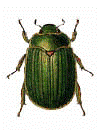Museum, University of Nebraska State
Document Type
Article
Date of this Version
2013
Citation
Moore MR, Jameson ML. 2013. Floral associations of cyclocephaline scarab beetles. Journal of Insect Science 13:100. Available online: http://www.insectscience.org/13.100
Abstract
The scarab beetle tribe Cyclocephalini (Coleoptera: Scarabaeidae: Dynastinae) is the second largest tribe of rhinoceros beetles, with nearly 500 described species. This diverse group is most closely associated with early diverging angiosperm groups (the family Nymphaeaceae, magnoliid clade, and monocots), where they feed, mate, and receive the benefit of thermal rewards from the host plant. Cyclocephaline floral association data have never been synthesized, and a comprehensive review of this ecological interaction was necessary to promote research by updating nomenclature, identifying inconsistencies in the data, and reporting previously unpublished data. Based on the most specific data, at least 97 cyclocephaline beetle species have been reported from the flowers of 58 plant genera representing 17 families and 15 orders. Thirteen new cyclocephaline floral associations are reported herein. Six cyclocephaline and 25 plant synonyms were reported in the literature and on beetle voucher specimen labels, and these were updated to reflect current nomenclature. The valid names of three unavailable plant host names were identified. We review the cyclocephaline floral associations with respect to inferred relationships of angiosperm orders. Ten genera of cyclocephaline beetles have been recorded from flowers of early diverging angiosperm groups. In contrast, only one genus, Cyclocephala, has been recorded from dicot flowers. Cyclocephaline visitation of dicot flowers is limited to the New World, and it is unknown whether this is evolutionary meaningful or the result of sampling bias and incomplete data. The most important areas for future research include: 1) elucidating the factors that attract cyclocephalines to flowers including floral scent chemistry and thermogenesis, 2) determining whether cyclocephaline dicot visitation is truly limited to the New World, and 3) inferring evolutionary relationships within the Cyclocephalini to rigorously test vicarance hypotheses, host plant shifts, and mutualisms with angiosperms.



Comments
This is an open access paper. Creative Commons Attribution 3.0 license